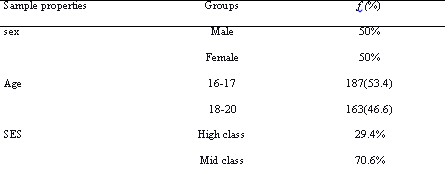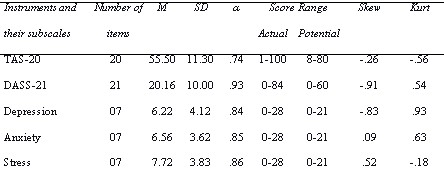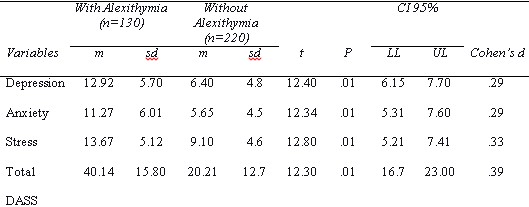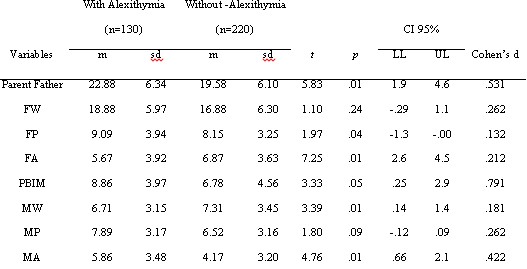Depression, Anxiety, Stress, and Parental Bonding among with and without Alexithymic Adolescents
1Sana Zainab, 1Naeema Arzeen, 2Saima Arzeen, & 2Hayat Muhammad*
1National University of Modern Languages and 2University of Peshawar
The current study aimed to explore the differences in depression, anxiety, stress, and parental attachment between adolescents with and without alexithymia. A total of 350 adolescents aged 13-17 years participated in the study. They were divided into two groups: those with alexithymia (n= 220) and those without alexithymia (n= 130). Data was collected from various institutions in Punjab and Khyber Pakhtunkhwa, including both public and private institutions. The participating adolescents were administered with several assessment tools, namely the PBI, TAS, DASS and a consent form. The results revealed significant differences in mean scores for DASS and PBI; adolescents with alexithymia reported higher levels of depression, anxiety, stress and overprotection, compared to those without alexithymia. The study suggested that individuals who face difficulties in expressing their emotions (alexithymia) and experience overprotection during adolescence may be more prone to psychological distress than those who have no difficulties in expressing their emotions.
Keywords: psychological distress; overprotection; parental bonding; alexithymia; adolescents
The ability to express emotions is essential for leading a happy and successful life, and young individuals often acquire these skills from their surroundings. Whether they grow up in a nuclear or joint family system, their environment plays a crucial role in their overall development. The demeanor and behavior exhibited by their family members can have both positive and negative impacts on the formation of their personalities and the development of psychological disorders. Depending on individual personality variations, some young people may encounter challenges such as alexithymia, which can adversely affect various aspects of their lives, including personal, educational, professional, and marital relationships. As children grow older, their early personality traits can serve as predictors for a wide range of positive and negative outcomes in their future, encompassing depression, anxiety, obsessive-compulsive disorder, stress, mood disorders, and other mental health issues.
In the 1970s, two psychiatrists, during their observations of patients with difficulties in emotional processing, introduced the term "Alexithymia." Nemiah and Sifneos (1970) define alexithymia as the inability to recognize and express emotions, which leads to a feeling of emptiness, a lack of creativity, communication difficulties, and a higher occurrence of negative emotions. Taylor (1984) presents an alternative definition, stating that individuals with alexithymia struggle to identify and describe their emotions and face challenges in distinguishing between emotional and physical sensations. In a more recent definition of alexithymia, Pellerone et al. (2017) describes it as a difficulty in expressing both their own and others' emotions, a deficiency in creativity and imagination, and a thinking style that primarily focuses on external aspects of events without effectively assimilating emotional information.
Depression is a mental disorder that impairs an individual's ability to engage in previously enjoyable activities, leading to persistent sadness and difficulties in carrying out daily tasks. On the other hand, anxiety is characterized by excessive worry and fear, and it poses a significant psychological risk, particularly among young individuals. According to Gar et al. (2005), alexithymia is associated with various psychological difficulties. For example, a study examining familial factors and anxiety found that children who perceived their parents as overprotective and controlling were more prone to developing psychological disorders, including anxiety disorders. Another investigation explored the connection between attachment styles, depression, and anxiety, and the results indicate that insecure attachment was linked to depression, anxiety, generalized anxiety disorder, and phobias. Furthermore, the results underscored the significant contribution of insecure attachment to the emergence of psychological difficulties (Bifulco et al., 2006). According to a meta-analysis conducted by Li et al. (2015), which encompassed both clinical and general population samples, individuals displaying alexithymic traits demonstrate higher levels of depression. Similarly, Ertekin et al. (2015) identified a strong correlation between alexithymia and social anxiety disorder as well as depression. The research also indicates that individuals without alexithymia experienced lower levels of social anxiety disorder and depression in comparison to those with alexithymia. In a study involving undergraduate students conducted by Lyvers et al. (2017), a significant association was observed between alexithymia and symptoms of depression and anxiety. Similarly, Tsuno et al. (2017) identify a significant relationship between alexithymia and symptoms of depression, anxiety, and stress in a sample of Japanese adults. Furthermore, Farina et al. (2021) conducted a study focusing on psychiatric adolescents, which reveals that alexithymic teenagers experienced a range of psychopathological symptoms, including internalizing problems, physical difficulties, preoccupation, anxiety, sadness, paranoia, psychoticism, aggression, and interpersonal hypersensitivity.
Researchers have also examined the association between parental bonding and the alexithymia presence or absence. Seiffge-Krenke (2011), Nanda et al. (2012), and Coccia et al. (2012) have all found significant links between parental connectedness, psychological control, and childhood anxiety. Their findings suggest that overprotective and authoritarian parenting styles can contribute to higher levels of anxiety in children. The role of perceived parental control and actual parental control in the development of anxiety is also noteworthy. However, a study conducted by Bahreini et al. (2012) reveals that high levels of overprotection and inadequate levels of care were linked to depression and low self-esteem. The results further demonstrate that overprotection heightens the vulnerability to depression among adolescents. Another study on a community sample reveals that dysfunctional family dynamics characterized by a lack of nurturance strongly predicted worry and anxiety (Spada et al., 2012). Similarly, other studies demonstrate a significant association between the severity of mental distress, stress, and parental bonding, particularly overprotection (Stenbaek et al., 2014; Valiente et al., 2014). In a study conducted by Khalid et al. (2018) on Pakistani school teenagers aged 11-18, a positive association was found between anxiety and parental bonding, specifically high levels of parental protectiveness and authoritarianism. This suggests that adolescents who experience more parental protection and authoritarianism also experience higher levels of anxiety. The researchers suggests that children who receive more care and warmth tend to have better mental health as adults. In contrast, those who experience high levels of parental overprotection, involvement, and neglect tend to exhibit more maladaptive behavior in adulthood (Burns et al., 2018). In a recent comparative study by Peh et al. (2020) on a sample of clinical (n=164) and non-clinical (n=510) individuals, clinical patients reported a significant association between parental care and bonding (overprotection) and symptoms of psychological illness and functioning.
Expanding upon prior research, the aim of this study is to investigate gender disparities in parental bonding and the impact on mental health outcomes among Pakistani adolescents, both with and without alexithymia. Alexithymia refers to a personality trait characterized by difficulties in recognizing, describing, and expressing emotions. It has been associated with various negative consequences, including impaired social functioning and poor mental health. Therefore, understanding the relationship between alexithymia, parental bonding, and mental health outcomes, specifically depression, anxiety, and stress, among adolescents is crucial for identifying early interventions and preventing future mental health problems. This study aims to provide insights into the prevalence of psychological distress and parental bonding in adolescents with and without alexithymia.
Method
The objective of this study was to examine the variations in depression, anxiety, stress, and overprotection between adolescents with alexithymia and those without alexithymia. The total sample for the study consisted of 350 adolescents, with 222 adolescents identified as alexithymic and 128 adolescents classified as non-alexithymic. The participants' age range was 13 to 17 years. Data was gathered through a convenient sampling method, encompassing multiple public and private educational institutions in the Attock, Rawalpindi, and Islamabad districts. The sample was divided into two groups based on their scores on the Toronto Alexithymia Scale (TAS-20), with the median score (cut-off score=50) used as the criterion. The group with alexithymia comprised 128 adolescents, while the group without alexithymia included 222 adolescents.
To accomplish this, the researcher obtained permission from the school and college authorities, as well as the teachers. Following the acquisition of informed consent from the participants, a set of demographic questionnaires and three scales, namely the Parental Bonding Instrument (PBI), Toronto Alexithymia Scale (TAS-20), and Depression Anxiety Stress Scale (DASS-21), were administered. Once the data collection was completed, the data was analyzed using SPSS 21. Descriptive statistics and t-tests were computed for all study variables.
Assessment Measures Parental Bonding InstrumentThe present study employed the 16 item Parental Bonding Instrument (PBI) to evaluate the level of surface-level parental bonding experienced by the participants rated on a 4-point Likert scale. To ensure its appropriateness for the study, the Urdu version of the PBI was validated by Kendler (1996). The PBI encompasses three dimensions, namely warmth, protectiveness, and authoritarianism. The cronbach's α was calculated, yielding a value of 0.69. Moreover, the reliability estimates for the warmth, protectiveness, and authoritarianism subscales were α = .80, α = .70, and α = .83, respectively. Toronto Alexithymia Scale
In this study, the Urdu version of the Toronto Alexithymia Scale, translated by Ghayas (2012), was employed. The scale comprises 20 items that were rated on a 5-point Likert scale, ranging from "strongly disagree" to "strongly agree." The internal consistency of the scale was assessed, and it demonstrated good alpha reliability (α = .88) specifically for this study.
DASS-21The current study utilized the Urdu version of the DASS-21 scale, which was translated by Ghayas (2012). The scale consists of 20 items that participants rated on a 5-point Likert scale, ranging from "strongly disagree" to "strongly agree." To evaluate the scale's internal consistency, its alpha reliability (α = .88) was assessed specifically for this study, indicating good reliability.
ProcedureAt the outset, a group of 350 students, comprising individuals of both genders, was chosen from educational institutions located in Islamabad, Rawalpindi, and Attock. The sample came from public and private schools and institutions with approval from authorities and teachers. Informed consent was obtained from the participants as the first step. Subsequently, a booklet containing a consent form, demographic sheet, and three scales was administered. The participants were provided with clear and concise instructions, emphasizing the importance of rating each item and completing all the questions. The study utilized the Urdu version of all three scales. Once the participants completed the questionnaires, they were thanked for their valuable participation and acknowledged. The researcher also thanked the school principal and class teacher before leaving. To meet study goals, replies were entered into SPSS-21 and analyzed. Reliability of all scales was assessed, and descriptive statistics were used to examine the distribution and suitability of the data. Pearson product-moment correlation analysis was employed to explore the relationships between variables, and appropriate analyses such as t-tests and regression were performed to compute the results.
Results
Table 1
Table 1 summarizes the study sample's demographics (N=350). The sample consists of an equal number of male and female participants, aged between 16 and 20 years, representing middle and late adolescence. The participants were chosen from diverse socio-economic backgrounds, including both upper and middle-class backgrounds.
Table 2 
In Table 2, the Descriptive statistics (M, SD & ranges) of the study variables are displayed. All scales had appropriate skewness and kurtosis values, indicating a normal data distribution for this investigation. All scales in the current sample are suitable for use, with alpha reliability values ranging from.74 to.93.
Table 3 
Table 3 displays the inter-scale correlations among all study variables. The findings indicate that all dimensions of psychological distress have positive and significant correlations with alexithymia TAS-20. The correlation values range from r=.15 to .34.
Table 4 
According to Table 4, there are significant values on DASS dimensions, with a t-value of 12.30 and a significance level of p<.01. Specifically, the scores for depression (12.40), anxiety (12.34), and stress (12.80) are significant. Adolescents with alexithymia have higher scores in all three scales, than those without alexithymia. The table demonstrates significant differences in psychological distress between adolescents with and without alexithymia, specifically in depression, anxiety, and stress.
Table 5 
A Table 5 data reveals that values on various PBI dimensions are significant; namely Father protectiveness (1.97), Parental bonding instrument for father (5.82), Father authoritarianism (7.25), Parental bonding instrument for mother (3.33), Mother warmth (3.39), and Mother authoritarianism (4.76) with a significance level of p<.01. The overall scores of overprotected adolescents in terms of alexithymia are higher than those of non-alexithymic adolescents. The table indicates significant differences in parental bonding sub-dimensions for both mothers and fathers with a significance level of p<.05. In general, the results suggest that overprotective adolescents tend to have higher scores in alexithymia.
Discussion
This study consists of two phases, the first one is qualitative while the second phase is situated in the quantitative paradigm. The particular design employed was an exploratory sequential mixed methods design, in which the first phase helps inform the second phase (Pardede, 2019).
The study hypothesized that adolescents experiencing emotional difficulties (alexithymia) would likely experience greater psychological distress compared to without alexithymia adolescents, and the results confirmed this hypothesis. Table 4 demonstrates that adolescents with alexithymia had elevated levels of depression, anxiety, and stress, while non-alexithymic adolescents reported lower levels of these psychological difficulties. Several theoretical models have proposed explanations for the relationship between alexithymia and psychological distress. One model suggests that alexithymia impairs effective emotion regulation, leading to negative emotions such as depression, anxiety, and stress (Moriguchi & Komaki, 2013). Another model suggests that alexithymia disrupts interpersonal relationships, resulting in a lack of social support and poorer mental health outcomes (Kooiman et al., 2004). These findings align with previous research conducted by De Berardis et al. (2021), Bhaskar et al. (2021), and Farina et al. (2021), which also found higher levels of depression and anxiety among alexithymic adolescents compared to non-alexithymic adolescents. Moreover, Farina et al. (2021) demonstrated that alexithymic adolescents experienced a range of psychopathological symptoms, including anxiety, depression, and interpersonal hypersensitivity.
The study hypothesis proposed that "Adolescents with alexithymia are expected to have higher levels of parental bonding (specifically, overprotection) compared to non-alexithymic adolescents" in terms of group differences. The results of the study support this hypothesis, as indicated in Table 5. Previous research has also found that individuals with alexithymia tend to experience lower levels of nurturance and higher levels of overprotection from their caregivers, which aligns with the current findings. Excessive parental protectiveness can instill a sense of incompetence in children, and its adverse effects on their development can contribute to emotional challenges (Tolmunen et al., 2011). Alexithymic adolescents reported increased degrees of despair, anxiety, stress, and perceived overprotection from their carers. On the other hand, non-alexithymic adolescents reported minimal or no such issues, as shown in Table 5 (Ahmed et al., 2021). The difficulty of alexithymic individuals in expressing and understanding their emotions leads to communication challenges and hindered personality development, thus exacerbating psychological problems such as anxiety, depression, and stress. Additionally, recent studies have indicated that overprotective parents can be perceived as controlling, intrusive, and authoritarian, negatively impacting the personality development of adolescents. Nevertheless, it is crucial to acknowledge the limitations of this study, which comprise its cross-sectional design and the restricted age range of 16 to 21 years, focusing on middle and late adolescents. To obtain a more comprehensive understanding of the subject, future research endeavors should adopt a longitudinal design and encompass a broader age spectrum.
Implications
The study findings reveal that alexithymic adolescents in Pakistan encounter psychological distress and perceive higher levels of overprotection from their caregivers. These results underscore the significance of implementing tailored interventions to support adolescents with alexithymia and improve their mental well-being. Moreover, the findings suggest that overprotective parenting practices can contribute to the exacerbation of psychological issues among adolescents. Hence, it is crucial to educate parents and caregivers about the potential adverse consequences of overprotection. Furthermore, future research should prioritize examining the long-term effects of alexithymia and overprotection on the mental health and overall well-being of adolescents. It is essential to investigate these factors within diverse cultural contexts and across various age groups to attain a comprehensive understanding of their impact. By doing so, we can develop a more nuanced comprehension of the relationship between alexithymia, parenting practices, and adolescent mental health. In summary, this study offers valuable insights into the influence of alexithymia on the mental health of adolescents and sheds light on the role of parenting practices in this context. The findings emphasize the necessity for targeted interventions, parental education, and further research to address the challenges faced by alexithymic adolescents and promote their overall well-being.
Limitations and Suggestions
While the study makes a valuable contribution to existing literature, it is crucial to acknowledge and address certain limitations. These limitations are as follows: First of all, the study has a restricted scope as it focuses only on adolescents who had both parents present, excluding those from broken families. To enhance the comprehensiveness of future research, it is advisable to incorporate adolescents from diverse family backgrounds. By including a more representative sample, the study findings would be more applicable to a broader population, providing a more comprehensive understanding of the relationship between depression, anxiety, stress, parental bond, and alexithymia among adolescents.
Secondly, the study exclusively targets adolescents enrolled in educational institutes, potentially limiting the generalizability of the findings. Future research should include a sample of unschooled teenagers. A comparison study of adolescents in schools and those who are not, might also be insightful.
Thirdly, the study examines how parental attachment affects alexithymia and psychological distress in teenagers using a cross-sectional approach. This approach provides valuable instantaneous information, but a longitudinal design would better comprehend the relationship over time. By observing changes and fluctuations in the variables, a more nuanced understanding of the dynamic nature of these relationships can be obtained. Longitudinal studies can also help establish causal relationships and capture developmental trajectories, contributing to a more comprehensive understanding of the impact of the parental bond on mental health outcomes in adolescents with and without alexithymia. Therefore, future researchers are encouraged to employ a longitudinal approach to obtain a more accurate picture.
Fourthly, the study narrows its attention to two adolescent age groups (middle adolescents and late adolescents) between the ages of 16 and 21. To examine the enduring effects of parental bonding on adolescents across various life stages, it is important to include a wider range of age groups.
Fifthly, the study's sample consists solely of urban adolescents from major cities in Pakistan, namely Attock, Rawalpindi, and Islamabad. To ensure a more representative sample, future research should aim to include adolescents from rural areas as well. Lastly, to enrich the study, it is important to consider the influence of other potential confounding variables, such as social support, family dynamics, and coping strategies. Exploring the interplay between these factors and the variables of interest would provide a more comprehensive understanding of the complex relationships involved in the mental health and parental bond of adolescents with and without alexithymia.
References
Ahmed, M. W., Bano, S., & Nawaz, S. (2021). The relationship between alexithymia, parental overprotection, and psychological distress in adolescents. Pakistan Journal of Medical Sciences, 37(1), 85-90. https://doi.org/10.12669/pjms.37.1.3629
Bahreini, M., Akbari, H., & Bahreini, M. (2012). The Effect of Alexithymia on Depression, Anxiety and Stress among Patients with Gastrointestinal Disorders. Journal of Research in Medical Sciences, 17(7), 618-621.
Bhaskar, L. V., Baliga, B. S., Madhavan, S. S., & Baliga, S. S. (2021). Alexithymia and Its Association with Anxiety and Depression in Early Adolescents. Indian Journal of Psychological Medicine, 43(2), 148-152. https://doi.org/10.1177/0253717620969155
Bifulco, A., Kwon, J., Jacobs, C., Moran, P. M., Bunn, A., & Beer, N. (2006). Adult attachment style as a mediator between childhood neglect/abuse and adult depression and anxiety. Social Psychiatry and Psychiatric Epidemiology, 41(10), 796-805. https://doi.org/10.1007/s00127-006-0094-x
Burns, R. A., Loh, V., Byles, J. E., & Kendig, H. L. (2018). Personality traits and co-morbid depression among Australian women: The mediating role of life stress. Archives of Women's Mental Health, 21(5), 599-608. https://doi.org/10.1007/s00737-018-0851-6
Coccia, M., Federico, B., & Cangialosi, F. (2012). Alexithymia and cognitive dysfunctions in patients with panic disorder. Psychiatric Quarterly, 83(2), 175-184. https://doi.org/10.1007/s11126-011-9189-6
Curcio, L. D., Mak, A. S., & George, A. M. (2019). Alexithymia predicts emotion recognition ability in individuals with and without depressive symptoms. Journal of Clinical Psychology, 75(2), 337-349. https://doi.org/10.1002/jclp.22664